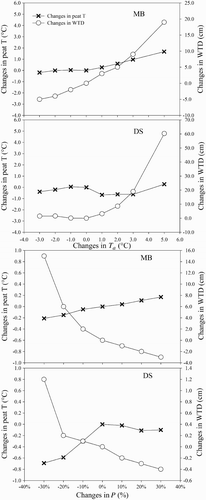Figures & data
Fig. 1 The basic coupling structure of the coupled land surface climate model (CLASS3W) and the peatland C model (MWM) (referred as CLASS3W-MWM).
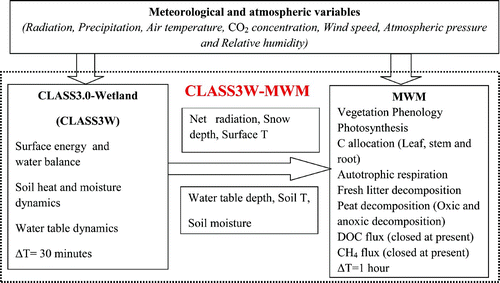
Table 1. The detailed physical characteristics and mean climate conditions for the two evaluation peatlands.
Table 2. Parameters and initial values used in CLASS3W-MWM for MB and DS.
Fig. 2 80-year simulation of (a) water table depth (WTD) and (b) the temperature of the first soil layer (soil1_T) based on the 10 repeated simulations of 1999–2006 for Mer Bleue (MB).
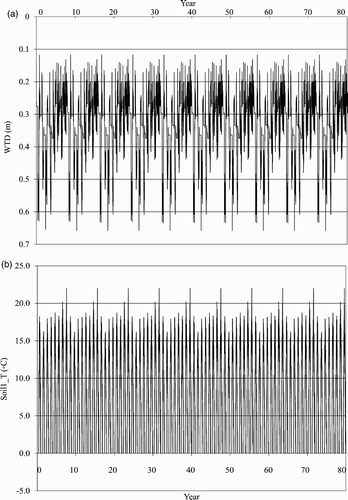
Fig. 3 Comparison of CLASS3W-MWM simulated summer WTD and the temperature of the first soil layer (soil1_T) with observations for MB ((a) and (b)) and Degerö Stormyr (DS) ((c) and (d)). The regression equation and r 2 are also shown. Note: The black line in the graph is the perfect 1:1 line.
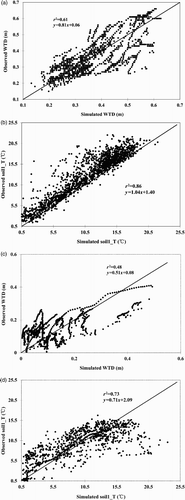
Table 3. CLASS3W-MWM simulated and observed annual GPP (GPP_M, GPP_O), TER (TER_M, TER_O), NEP (NEP_M, NEP_O) for MB; and the annual NPP and the percentage contribution of each simulated component. The suffix “O” represents observed fluxes and “M” represents simulated fluxes. The 8-year average (Ave) is also shown. For comparison, the stand-alone MWM simulated fluxes (GPP_MO, TER_MO, NEP_MO), based on observed soil temperature and WTD, are also presented (reproduced from St-Hilaire et al. (Citation2010)). The anomalies of annual average air temperature (ΔT) and precipitation (ΔP), relative to the 8-year average value (Ave), are shown.
Table 4. CLASS3W-MWM simulated GPP (GPP_M), TER (TER_M), NEP (NEP_M), NPP (NPP_M) and observed NEP (NEP_O), and the percentage contribution of each simulated component for DS. The suffix “O” represents observed fluxes and “M” represents simulated fluxes. The 6-year average (Ave) is also shown. For comparison, the stand-alone MWM simulated fluxes (GPP_MO, TER_MO, NEP_MO), based on observed soil temperature and WTD, are also presented (Wu et al., unpublished manuscript). The annual average air temperature anomalies (ΔT) and precipitation anomalies (ΔP), relative to the 6-year average value (Ave), are shown.
Fig. 4 Temporal trend and comparison of daily observed and CLASS3W-MWM simulated GPP (top panel), TER (middle panel) and NEP (bottom panel) for 1999–2006 for MB (the filled black circles show the observed CO2 fluxes, and the open red circles show the CLASS3W-MWM simulated CO2 fluxes).
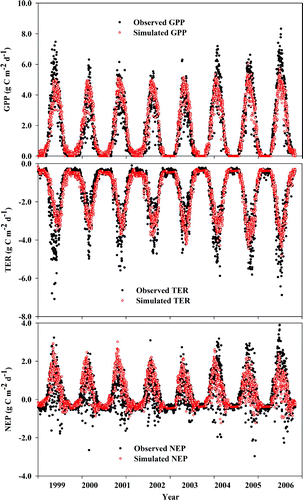
Fig. 5 Temporal trend and comparison of daily observed and CLASS3W-MWM simulated NEP for 2001–06 for DS (the filled black circles show the observed NEP, and the open red circles show the CLASS3W-MWM simulated NEP).
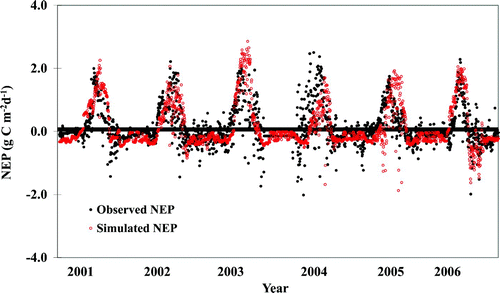
Fig. 6 The 1:1 scatterplots of observed and CLASS3W-MWM simulated daily GPP and TER for MB for 1999–2006. The solid black line is the perfect 1:1 line. The filled circles show the GPP, and the open circles show the TER. The regression equation r 2, d*, and the RMSE are also shown.
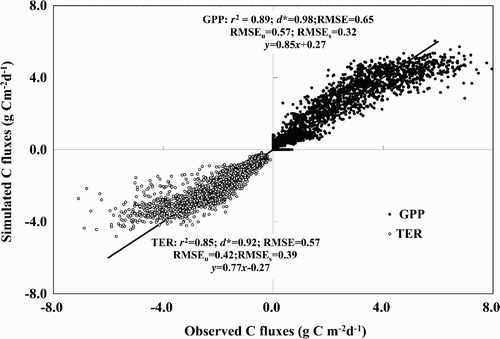
Fig. 7 The 1:1 scatterplots of observed and CLASS3W-MWM simulated daily NEP for MB for 1999–2006 (top panel) and DS for 2001–06 (bottom panel). The solid black line is the perfect 1:1 line. The regression equation r 2, d*, and the RMSE are also shown.

Table 5. Sensitivity of CLASS3W-MWM simulated GPP, AR, NPP , NEP, TER, OxicHR and AnoxicHR to changes in air temperature (Ta ), precipitation (P), atmospheric CO2 concentration ([CO2]) and combinations of these, expressed as a relative change in percentage of the base line fluxes, for Mer Bleue (MB) (a) and Degerö Stormyr (DS) (b). Negative percentage changes indicate a decrease, and positive percentage changes indicate an increase relative to the base line value. The percentage change is calculated by “(new value-base line)/base line × 100”. The baseline C fluxes were calculated based on CLASS3W-MWM using present-day climate inputs. Changes in Ta were imposed by its absolute changed values, whereas changes in precipitation were imposed by its relative changed percentage. Positive changes in Ta indicate warmer temperatures, and negative changes in Ta indicate cooler temperatures. Negative changes in precipitation indicate decreased precipitation, and positive changes indicate increased precipitation. Only doubled atmospheric CO2 concentration was applied (2 × CO2). Care should be taken that the changes were evenly distributed in the study period. The last three columns show the absolute C fluxes for GPP, TER and NEP when those changes were imposed.
Fig. 8 The changes in peat temperature (T: °C) and WTD (cm) relative to the baseline simulated peat temperature and WTD responding to changes in air temperature (Ta : °C) (top two panels) and changes in precipitation (P: %) (bottom two panels). Note: (1) Positive changes in peat temperature indicate an increase, and negative changes indicate a decrease; positive changes in WTD indicate an increase (or drier conditions), and negative changes indicate a decrease (or wetter conditions). (2) Different scales are used for changes in WTD for MB and DS.
